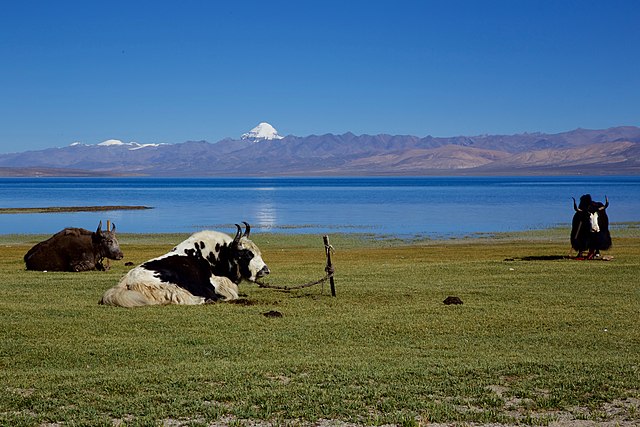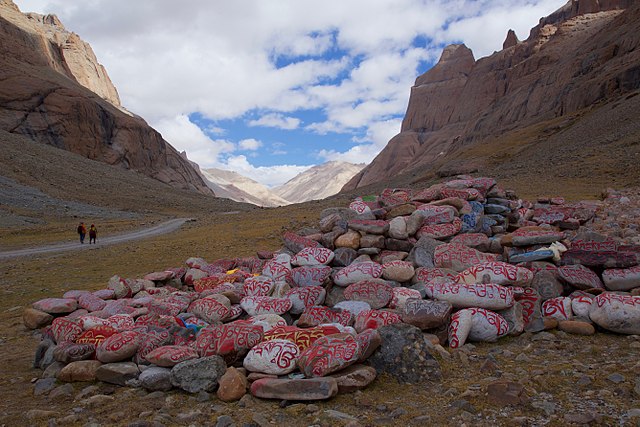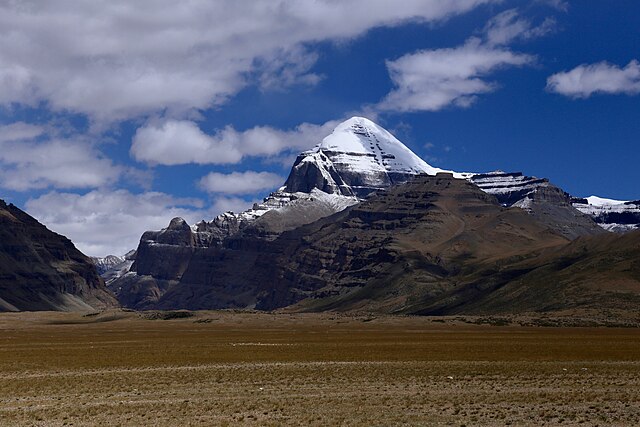Trip Facts
-
Duration
15 Days
-
Trip Start and End
Kathmandu/ Kathmandu
-
Difficulty Level
Moderate
-
Trip Area
Tibet
-
Maximum Altitude
5630m/18,471.13ft
-
Best Season
Sep-Nov, Feb-May
-
Meals
Full board (please check the details)
-
Accommodation
Hotel, Guesthouses
-
Transportation
Jeep or Bus
Highlights
Cultural Immersion: Explore the rich cultural heritage of Kathmandu.
Scenic Drives: Enjoy stunning landscapes from lush valleys to the Tibetan plateau.
Spiritual Sites: Visit sacred sites like Lake Mansarovar and Mount Kailash.
Trekking Adventure: Challenge yourself with the Mount Kailash Kora.
Local Encounters: Meet diverse communities and experience Tibetan hospitality.
Trip Overview
Embark on a spiritual and adventurous journey to Mount Kailash and Lake Mansarovar, a once-in-a-lifetime experience offered by our travel agency. This journey begins in the vibrant city of Kathmandu, Nepal, where you'll immerse yourself in the rich culture and history of this ancient city. From Kathmandu, your adventure takes you through the breathtaking landscapes of the Himalayas, known for their rugged beauty and serene vistas.
Mount Kailash, revered by Hindus, Buddhists, Jains, and Bonpos, is considered the center of the universe and the ultimate destination for pilgrims. As you approach this majestic peak, you'll feel the profound spiritual energy that surrounds it. The journey to Mount Kailash is not just a trek; it's a pilgrimage that allows you to connect deeply with your spirituality. The ritual of circumambulating the mountain, known as the Kora, is a sacred practice believed to bring spiritual purification and enlightenment.
Nearby, Lake Mansarovar, one of the highest freshwater lakes in the world, offers a serene and reflective experience. The pristine waters of the lake are said to cleanse the soul and body, and many pilgrims take a ritual dip in its holy waters. The lake, surrounded by snow-capped peaks, provides a tranquil setting for meditation and contemplation.
Throughout this journey, you'll encounter the unique cultures and traditions of the Tibetan people. Their warm hospitality and rich heritage add a profound cultural dimension to your trip. You'll visit ancient monasteries, meet local monks, and learn about their spiritual practices and way of life.
Our travel agency ensures that your journey is comfortable and enriching. We provide experienced guides who are knowledgeable about the region's geography, history, and spiritual significance. They will assist you in navigating the challenging terrains and high altitudes, ensuring your safety and well-being throughout the trip.
The journey to Mount Kailash and Lake Mansarovar is more than just a trek; it's a transformative experience that offers a deep connection to nature and spirituality. Whether you are seeking spiritual enlightenment, adventure, or simply a break from the routine, this journey promises to leave you with lasting memories and a renewed sense of self.
Join us for this extraordinary journey and discover the profound beauty and spiritual essence of Mount Kailash and Lake Mansarovar. Let us take you on an adventure that transcends the physical and touches the soul.
Mt. Kailash and Mansarovar Lake
+ Show MoreYour adventure begins as you arrive in Kathmandu, the vibrant capital of Nepal. Upon landing at Tribhuvan International Airport, you’ll be transferred to your hotel. Spend the day exploring the bustling streets of Thamel, where narrow alleys are lined with vibrant shops and cozy cafes. In the evening, enjoy a welcome dinner where you’ll meet your fellow travelers and the guides who will accompany you on this incredible journey.
- Hotel
- 1400
Cost Includes
- All land transportation and domestic flights as required for the trip itinerary
- Pick-ups and Drop-offs in a private vehicle at the airport (Arrival & Departure)
- Hotel Accommodations (Bed & Breakfast) in the city
- 3-course meal (Breakfast, Lunch, & Dinner) during the entire trek
- Accommodations in teahouses/guesthouses/lodges and tented camps as per the nature of the trek
- Necessary trek permits, national parks, and restricted areas entrance fees
- Tent camps equipment, kitchen equipment for camping treks
- First-aid Medical Kits
- Experienced and government license holder English-speaking trekking guides
- Porters (2 trekkers: 1 porter), supporting crews, cooks, & asst. cooks (depending on the nature of the trek)
- Allowances for crew staff including insurance on medical grounds
- All government taxes, official charges
- Tibetan Travel Permit and other China regulatory processes
- Emergency rescue (if needed)
Cost Excludes
- International Airfare
- Nepal Entry Visa Fees
- Airport taxes at the time of departure
- Personal Expenses
- Additional charges in the tea/guesthouses (Wi-Fi, electricity charge, hot shower, laundry, boiled water)
- Meals (Lunch & Dinner) in Kathmandu
- Extra night’s stay accommodation and meals in Kathmandu
- All kinds of Alcoholic & Non-alcoholic Beverages, Mineral Water
- Personal Trekking Gears
- Emergency Rescue cost & Travel Insurance cost
- Tips to the supporting crew members (guides, porters, drivers) after the trip completion
- All expenses need to be bear themselves in case of political instability & unforeseen events
Altitude Acclimatization: Several days are allocated for acclimatization to prevent altitude sickness.
Physical Fitness: Ensure you are physically prepared for trekking and high altitudes.
Spiritual Significance: Respect local customs and the spiritual nature of the journey.
Guidelines
Accommodation
Accommodations in the Himalayas are mostly teahouses/guesthouses/lodges in the Tibet Region. In the city, the hotel is the accommodation. Generally, the teahouses are simple with basic facilities but comfortable to stay in. For the use of Wi-Fi, charging electronic devices, hot water buckets, laundry, and boiled water, trekkers must pay an additional charge. For peak climbing, accommodation is tented camps.
Meals
In the city, only breakfast is provided. During the entire trek in the Everest region, a full 3-course meal (breakfast, lunch, and dinner) is provided from the teahouses. The meals are basic but organic and healthy suitable for the health of the trekkers. The prime dish is Nepali Dal-Bhat served with vegetable curry and pickles. Besides Dal-Bhat, noodles, soups, Sherpa stew, hot drinks, roti, and fresh curries are served. There is no variety of meals at the teahouses but one can enjoy the continental dishes at Namche at your personal expense.
For trekking meals are prepared by a professional cook who accompanied us during the trek. All necessary kitchen equipment is carried with us. The meals prepared during the treks are healthy and hygienic. It provides great energy for trekkers/climbers.
Drinking water
Drinking water keeps the body hydrated which is essential during the trek. In the Himalayas, water is pure and fresh. One can directly drink water from the natural stream from the Himalayas. Or one can fill up the boiled water at the teahouses paying an additional charge. Water-purifying solution kits are a must. So, always carry for safe water treatment and to stay safe & healthy. Remember to carry a water bottle to minimize the use of plastic bottles.
Communication
Certain areas will have the internet connectivity, which may not be stable and easily accessible in the Tibetan plateau. One can also purchase a local Sim to use the phone and mobile data internet.
Required Permits
- Nepal Visa
- Tibetan Travel Permit
Travel Insurance
Travel Insurance is required while trekking in Nepal and Tibet. Travel Insurance makes your journey stress-free. It acts as a safety tool that prevents unforeseen and unwanted events during the travel journey. One must get travel insurance from a trusted insurance company. It must cover all emergencies, flight cancelations, loss/theft of luggage, altitude over 3000m, evacuations, and medical difficulties.
Safety and our guides
The client’s safety is our topmost priority. So, when it comes to safety one can 100% trust us. Our guides are certified and have years of experience in this field. They are aware of the technical difficulties, altitude sickness, and health of the trekkers in the Himalayas. Thus, they are fully prepared and always carry necessary medical kits, safety tools, and are experts in safety performances. From the beginning to the end of the trek, the client’s safety is taken into consideration and kept as a high priority. Therefore, all the program itineraries are carefully planned and scheduled with proper acclimatization and rest days to prevent altitude sickness and adapt to the higher altitude. We are 24/7 available at your service. Hence, feel free to ask queries and share your thoughts.
Best time for Mt Kailash Trek
All seasons have their beauty. But, when it comes to trekking in the Mt Kailash region, Spring and Autumn seasons are termed best. These two seasons are the best time to explore as the weather is clear, the days are bright, and trekking trails are easy to walk. Spring and Autumn season is followed by the Summer season to trek in the Everest region. Winter and Rainy seasons are riskier due to muddy, slippery, and snowy trails. The weather is also uncertain and the chances of the temperature rising are high making it cold for the trekkers. It is advisable to properly plan before trekking in the rainy and winter seasons in the Everest region.
Mt Kailash Trek Difficulty
Mt Kailash Trek is moderately difficult to extremely challenging depending on the trek duration, elevation, and trail structure. The trek trails include several steeps ascends, and descends, rugged trails, and high elevations. The trek difficulty is the part of the trekking journey which is inevitable. But, to lessen the difficulty during the trek, trekkers must be physically and mentally fit before the start of the trek. The trekking experience at the high altitude is a plus point for the trekkers. Trekkers can take part in physical training, exercises, short day hikes, cardiovascular exercises, and healthy diets. Take essential health tests and keep yourself motivated before the trekking journey. Here, our assistance is always there throughout the trekking journey.
Altitude Sickness and Acclimatization
Altitude sickness is common at an altitude above 3000m. Here in the himalayas, during trekking, altitude sickness chances are high. The high elevation, the weather, and the temperature play a key role. Thus, to prevent altitude sickness acclimatization is quintessential. Thus, the acclimatization rest days are carefully scheduled to adapt to the surroundings. All age groups and even healthy people can suffer from altitude sickness. But, no need to panic as its symptoms and precautionary advice is given below:
Altitude Sickness Symptoms
The symptoms of altitude sickness are primary at the initial stage and get extreme if primary symptoms are not taken into consideration.
Primary symptoms: Headache, vomiting, breathlessness, loss of appetite & sleep, tiredness, vertigo
Extreme symptoms: primary symptoms along with delusions & unconsciousness
Precautionary Advice
- Inform the guide immediately
- Stretch the body and do warm up before the start of the trekking journey
- Keep yourself hydrated by drinking water at regular intervals
- Urinate frequently throughout the journey
- Keep it slow and steady
- Take proper rest and sleep
- Avoid taking salty and unhygienic foods
- Avoid consuming alcohol, and smoking
- If it feels uneasy or difficult, immediately descend
- Consult a guide to taking a medicine
Porter Luggage limitation
One porter is assigned to carry the luggage of two trekkers. The luggage limitation is a maximum of 15 kg per trekker.
Equipment checklist
Essential Documents: Passport, Travel Permits, Visa Photocopy, Passport size photos
Food: Light snacks, Energy bars, and drink mix
Shoes: Camp shoes, Pair of hiking boots, Rubber sandals
Clothes: Windcheater jacket, Thermals, Insulating Down Jacket, Fleece, Long sleeve shirts, Gloves, Towels, Inner garments, Trekking pants, Trousers, Shorts, Socks, Raincoat, Balaclava, Bandana, Gaiters
Accessories: Sunglasses, Hats/Caps, Sunscreen, Lip Balm, Water bottles, Pocket Knife, Solar chargers, Batteries, Head Lamps, Torch, Umbrella, Sewing kit, Water Purifying solution kits, reusable bags to deposit waste, and separate clean/dirty clothes
Equipment & Gears: Warm Sleeping bags, Map, Trekking poles, Duffel bag, Carabiners, Crampons, Tapes/Slings, Ice Screws, Ice Ax, Harness, Rope, Spikes
Medicine: First-Aid Kit, Altitude sickness medicines, Insect repellents, Blister kits, Approved medicines
Rainy season: Waterproof clothes, boots, Raincoat, Anti-leech socks
Winter Season: Light woolen clothing items
Personal Hygiene Kit: Hand sanitizer, wet wipes, napkins, sachet shampoo, moisturizer, hand wash/soaps, toothbrush, toothpaste, comb/brush, razor, and for ladies (menstrual kits)
Note: One can customize the above. Only bring necessary items from the provided list from your home or one can rent or purchase here in Nepal.
Tourist Information on Nepal Visa
Visa Requirements
Travelers visiting Nepal must obtain a visa, which can be acquired upon arrival at Tribhuvan International Airport in Kathmandu or at land border entry points. Additionally, visas can be obtained in advance from Nepalese embassies and consulates worldwide.
Types of Tourist Visas
- Visa on Arrival:
- Available at: Tribhuvan International Airport (Kathmandu) and various land border points.
- Required Documents:
- A valid passport with at least six months’ validity.
- A completed visa application form (available online or at the point of entry).
- Passport-sized photographs.
- Visa fee (payable in cash; major currencies are accepted).
- Visa from Nepalese Embassies/Consulates:
- Procedure:
- Visit the nearest Nepalese embassy or consulate.
- Submit a completed visa application form.
- Provide passport-sized photographs.
- Pay the visa fee.
- Processing time varies; it can take a few days to a week.
- Procedure:
Visa Fees
- 15 days: USD 30
- 30 days: USD 50
- 90 days: USD 125
Visa Extensions
- Where to Apply: Department of Immigration offices in Kathmandu and Pokhara.
- Extension Fees:
- USD 45 for a 15-day extension.
- USD 3 per day for each additional day beyond the initial extension.
- USD 5 per day for an overstay penalty.
Gratis (Free) Visa
Nepal provides free visas to:
- Children under 10 years.
- SAARC countries (except Afghanistan) for a 30-day stay within the calendar year.
- Chinese nationals.
Multiple Entry Visas
- Available for an additional USD 20 fee.
- Recommended for travelers planning to visit neighboring countries and re-enter Nepal.
Important Tips
- Payment:
- Visa fees can be paid in various major currencies, but carrying small denominations of USD is advisable.
- Application Form:
- The visa application form can be filled out online before arrival at Nepal Immigration.
- Photographs:
- Have multiple passport-sized photographs ready.
- Visa Validity:
- Ensure your passport is valid for at least six months from the date of entry.
- Health Requirements:
- Check if any vaccinations are required or recommended.
- Travel Insurance:
- Highly recommended to have travel insurance that covers health, accidents, and theft.
Entry Points
Nepal has several entry points for tourists:
- Air: Tribhuvan International Airport (Kathmandu).
- Land:
- Kakarbhitta (Eastern Nepal, bordering India).
- Birgunj/Raxaul (Central Nepal, bordering India).
- Belahiya/Sunauli (Western Nepal, bordering India).
- Nepalgunj (Mid-Western Nepal, bordering India).
- Dhangadhi (Far Western Nepal, bordering India).
- Mahendranagar (Far Western Nepal, bordering India).
- Kodari (Northern border with Tibet, currently closed due to road conditions).
For the most current information, it’s advisable to check the official website of the Nepal Department of Immigration or contact your nearest Nepalese embassy or consulate before planning your trip.
Tibetan Travel Permit
Visa and Permit Requirements for Mount Kailash:
- Chinese Visa:
- All travelers entering Tibet, including Mount Kailash, must obtain a Chinese visa from a Chinese embassy or consulate in their home country.
- Tibet Travel Permit (TTP):
- Issued by the Tibet Tourism Bureau.
- Required for entry into Tibet Autonomous Region (TAR), where Mount Kailash is located.
- Alien’s Travel Permit (ATP):
- Needed for travel to restricted areas within Tibet, including Mount Kailash.
- Military Permit:
- Required for travel to sensitive border areas, such as Mount Kailash.
- Foreign Affairs Permit:
- Necessary for travel to regions requiring additional clearance, like Mount Kailash.
We will obtain all the required documents in Kathmandu before our departure.





